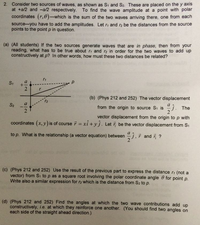Question
thumb_up100%

Transcribed Image Text:2. Consider two sources of waves, as shown as St and S2. These are placed on the y axis
at +a/2 and -a/2 respectively. To find the wave amplitude at a point with polar
coordinates (r,0)-which is the sum of the two waves arriving there, one from each
source-you have to add the amplitudes. Let r, and r2 be the distances from the source
points to the point p in question.
(a) (All students) If the two sources generate waves that are in phase, then from your
reading, what has to be true about r, and r2 in order for the two waves to add up
constructively at p? In other words, how must these two distances be related?
S1
(b) (Phys 212 and 252) The vector displacement
S2
a
from the origin to source Si is
The
vector displacement from the origin to p with
coordinates (x, y) is of course 7 = xi +yj. Let be the vector displacement from S1
%3D
to p. What is the relationship (a vector equation) between
i and i ?
(c) (Phys 212 and 252) Use the result of the previous part to express the distance r, (not a
vector) from S, to p as a square root involving the polar coordinate angle 0 for point p.
Write also a similar expression for r2 which is the distance from S2 to p.
(d) (Phys 212 and 252) Find the angles at which the two wave contributions add up
constructively, i.e. at which they reinforce one another. (You should find two angles on
each side of the straight ahead direction.)
Expert Solution
This question has been solved!
Explore an expertly crafted, step-by-step solution for a thorough understanding of key concepts.
This is a popular solution
Trending nowThis is a popular solution!
Step by stepSolved in 3 steps with 2 images

Knowledge Booster
Similar questions
- Use dimensional analysis to find how the speed vvv of a wave on a string of circular cross section depends on the tension in the string, T, the radius of the string, R, and its mass per volume, ρ (rho). Express your answer in terms of the variables T, R, and ρ(rho).arrow_forwardWe will assume that a sound wave, once generated and emitted, will propagate uniformly in all directions of 3-dimensional space. Find an expression for the displacement s(r, t) of the air particles from equilibrium, where r is the radial distance from the source, and t is time. Introduce physical constants/coefficients, with appropriate physical dimensions, when necessary.arrow_forwardondearrow_forward
- 7. 8. 9. PQ represents the boundary between regions I and II, having different depths, in a ripple tank containing water. Wave fronts are shown crossing the boundary. (a) (b) (c) (d) (e) I NOTE: v represents wave velocity A represents wavelength f represents frequency T represents period II (a) (b) (c) (d) (e) Which of the following correctly describes the waves in region II as compared to those in region I? In region II, f is the same, v is less, and A is less than in region I. In region II, f is the same, v is greater, and A is greater than in region 1. In region II, f is the same, v is greater. and A is less than in region I. In region II, v is the same, T is less, and A is less than in region I. In region II, v is the same, T is greater, and A is less than in region I. When two point sources placed a fixed distance apart vibrate in phase, nodal lines are produced. Which one of the following statements concerning these lines is incorrect? Energy is transmitted away from the sources…arrow_forwardShow by direct substitution that the exponential Gaussian function defined by ?(x,t) = ae-(bx-ct)^2 satisfies the wave equation: (?2?(?,?))/(?x2) = (1/v2) * (?2?(x,t))/(?t2) if the wave is given by the v = (c/b) and a, b, and c are constants.arrow_forwardTwo harmonic waves are given by: y1=Acos(kx−ωt) and y2=Asin(kx−wt+π/3) where k=5πm−1, ω=800πs−1 and A=4.0cm sin(theta1) +/- sin(theta2) = 2sin( (theta1 +/- theta2) /2) cos( (theta1 -/+ theta2) /2) Using the provided identity, find the equation of the resultant wave and its amplitude. Show all work.arrow_forward
- A wave propagation is represented by y = 4 sin (20nt – x) where x is in cm and t is in s. Calculate the 4. (a) (b) (c) Wavelength Frequency Velocity [1 = 12 m; f = 10 Hz; v = 120 ms-1]arrow_forwardS A person stands 13.00 m from a speaker, and 8.00 m from an identical speaker. What is the wavelength of the first (n=1) interference maximum (constructive)? (Speed of sound = 343 m/s) (Unit = m) demy of Science. All Rights Reserved. =h H K hulu 20 Enter New ✔arrow_forward
arrow_back_ios
arrow_forward_ios